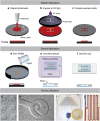Build your own soil: exploring microfluidics to create microbial habitat structures
- PMID: 29135971
- PMCID: PMC5776464
- DOI: 10.1038/ismej.2017.184
Build your own soil: exploring microfluidics to create microbial habitat structures
Abstract
Soil is likely the most complex ecosystem on earth. Despite the global importance and extraordinary diversity of soils, they have been notoriously challenging to study. We show how pioneering microfluidic techniques provide new ways of studying soil microbial ecology by allowing simulation and manipulation of chemical conditions and physical structures at the microscale in soil model habitats.
Conflict of interest statement
The authors declare no conflict of interest.
Figures


References
-
- Antwis RE, Griffiths SM, Harrison XA, Aranega-Bou P, Arce A, Bettridge AS et al. (2017). Fifty important research questions in microbial ecology. FEMS Microbiol Ecol 93: 1–10. - PubMed
-
- Bhatia SN, Ingber DE. (2014). Microfluidic organs-on-chips. Nat Biotechnol 32: 760–772. - PubMed
-
- Boswell G. (2003). Growth and function of fungal mycelia in heterogeneous environments. Bull Math Biol 65: 447–477. - PubMed
-
- Deng J, Orner EP, Chau JF, Anderson EM, Kadilak AL, Rubinstein RL et al. (2015). Synergistic effects of soil microstructure and bacterial EPS on drying rate in emulated soil micromodels. Soil Biol Biochem 83: 116–124.

